Unlock Time-Dependent Inhibition Insights with Continuous Enzyme Assays
Gain precise, real-time data on kinase activity and inhibition with AssayQuant's PhosphoSens Enzyme and Inhibitor Solutions. Products and Services designed to support faster, more accurate drug discovery efforts.
Why Detailed Preclinical Characterization Matters
As interest in time-dependent inhibition (TDI) grows in today's kinase and drug discovery research, it's becoming clear that traditional end-point assays fall short in accurately measuring inhibitor potency. While end-point assays have historically been the standard, they struggle to capture the complexities of time-dependent inhibition.
The main limitation of end-point analysis is its assumption that the initial reaction rate remains constant throughout the study. This leads to inaccuracies, as critical phases like initial lag or saturation near the end of the reaction curve go undetected.
PhosphoSens Technology offers a solution with continuous assays that provide deep kinetic quantification of a compound’s time-dependent inhibition—delivering more precise and actionable data with ease.
Time-Dependent Inhibition Workflow Using AssayQuant's PhophoSens Continuous Assay Technology
In the presentation, we walk you through our TDI (time-dependent inhibition) workflow, which includes:
- Determination of the presence/absence of time-dependent inhibition
- If time-dependent, determine reversibility/irreversibility
- Quantitative characterization of the reversible or irreversible inhibition
And we'll show you how this workflow yields the kinetic parameters that are of greatest interest to research and drug discovery.
Download the PDF Presentation To Discover How Continuous Assays Improve Your TDI Studies
Presentation Includes:
- PhosphoSens Technology overview enabling a continuous assay format
- Comparison of continuous and end-point assays
- Introduction to time-dependent inhibition (TDI)
- PhosphoSens workflow for TDI
- Determination of reversible/irreversible inhibitor binding
- Reversible inhibitor characterization:
- koff (off-rate)
- t1/2 (half-life)
- τ (tau, residence time)
- Irreversible inhibitor characterization:
- kinact (max rate of inactivation)
- KI (kinetic binding constant)
- kinact/KI (inactivation efficiency)
- When to report IC50, and when to report kinact/KI

No Hassle, Just Solutions—Contact Us and Let’s Work Together to Solve Your Research Challenges
Kinetic Questions. Kinetic Answers.
Stay Informed
Want to hear the latest about our technology? Be among the first to learn about our latest products and services.